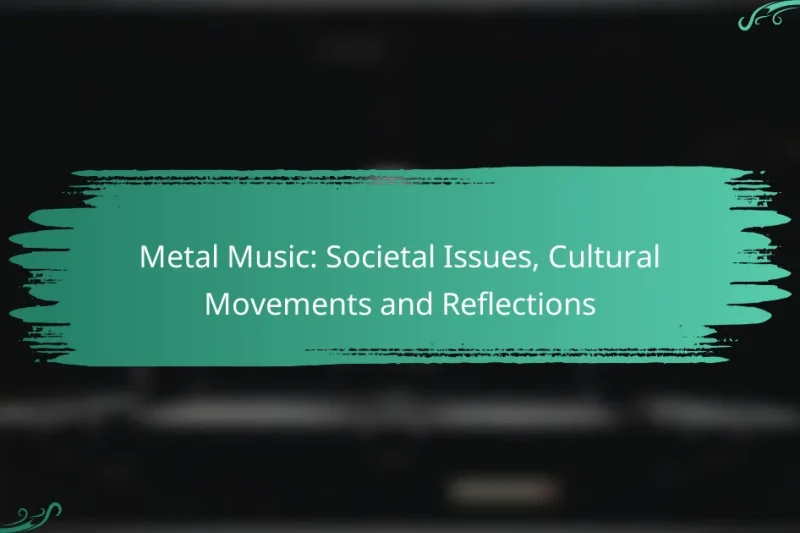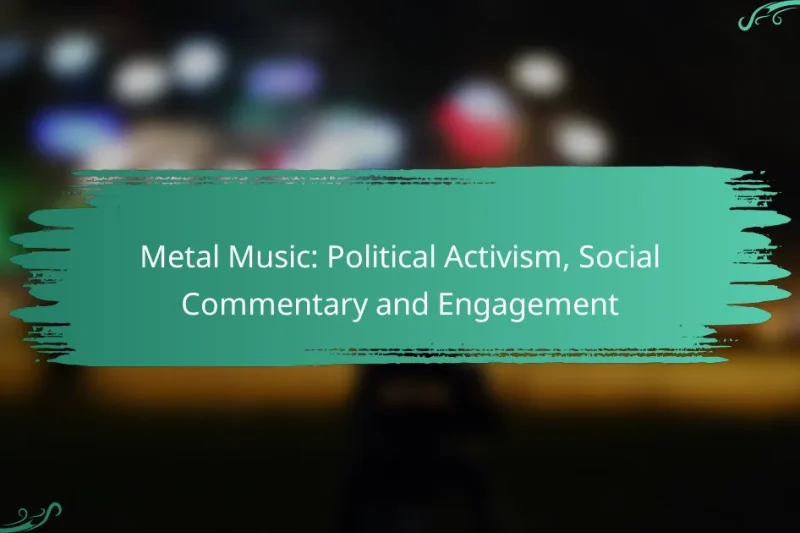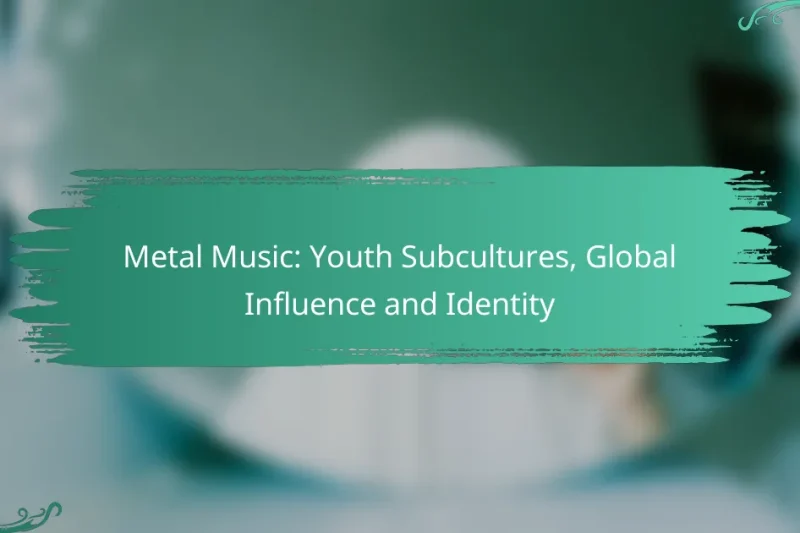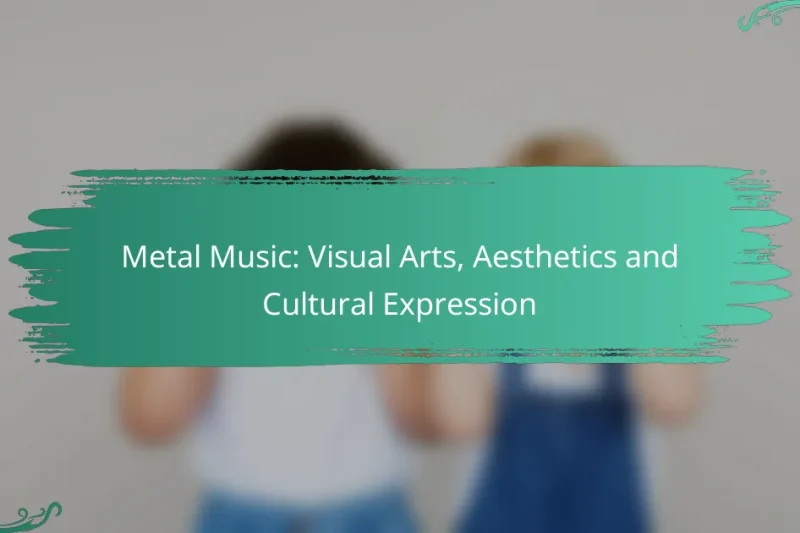Metal music plays a crucial role in shaping film soundtracks and television shows, adding intensity and … Metal Music: Film Soundtracks, Television Influence and ImpactRead more
Cultural Impact of Metal Music
Metal music has a profound cultural impact, particularly in the United States, where it shapes youth identity and fuels social movements. With its themes of rebellion and empowerment, metal resonates deeply with listeners, fostering a sense of community among fans while reflecting societal issues and personal struggles. Additionally, the genre influences fashion trends, promoting distinctive styles that embody its rebellious spirit.
Metal Music: Societal Issues, Cultural Movements and Reflections
Metal music serves as a potent vehicle for exploring and critiquing societal issues, utilizing its aggressive … Metal Music: Societal Issues, Cultural Movements and ReflectionsRead more
Metal Music: Political Activism, Social Commentary and Engagement
Metal music plays a crucial role in political activism by leveraging its powerful platform to confront … Metal Music: Political Activism, Social Commentary and EngagementRead more
Metal Music: Youth Subcultures, Global Influence and Identity
Metal music plays a pivotal role in shaping youth subcultures globally, offering a unique blend of … Metal Music: Youth Subcultures, Global Influence and IdentityRead more
Metal Music: Global Reach, Cultural Variations and Acceptance
Metal music has emerged as a diverse and influential genre with varying degrees of acceptance around … Metal Music: Global Reach, Cultural Variations and AcceptanceRead more
Metal Music: Visual Arts, Aesthetics and Cultural Expression
Metal music profoundly influences visual arts and aesthetics, creating a unique style that mirrors its themes … Metal Music: Visual Arts, Aesthetics and Cultural ExpressionRead more
Metal Music: Fashion Trends, Styles and Decades
Metal music fashion is a vibrant expression of the genre’s rebellious spirit, evolving significantly since its … Metal Music: Fashion Trends, Styles and DecadesRead more
How does metal music influence culture in the United States?
Metal music significantly influences culture in the United States by shaping youth identity, contributing to social movements, and representing various subcultures. Its themes often resonate with listeners, fostering a sense of community and shared values among fans.
Impact on youth identity
Metal music plays a crucial role in shaping youth identity by providing a platform for self-expression and individuality. Many young fans identify with the genre’s themes of rebellion, empowerment, and authenticity, which can help them navigate the challenges of adolescence.
Through concerts, festivals, and online communities, metal fans often find a sense of belonging. This connection can enhance their confidence and encourage them to embrace their unique identities, often leading to the formation of tight-knit social groups.
Contribution to social movements
Metal music has historically contributed to various social movements by addressing issues such as inequality, war, and mental health. Bands often use their lyrics and public platforms to raise awareness about societal problems, inspiring fans to engage in activism.
For example, many metal artists have participated in benefit concerts and charity events, leveraging their influence to support causes like environmental protection and human rights. This activism not only amplifies the messages of the movements but also strengthens the bond between artists and their audience.
Representation of subcultures
Metal music serves as a representation of diverse subcultures, including goth, punk, and alternative communities. Each subgenre often reflects specific cultural values and aesthetics, allowing fans to connect with their heritage and express their beliefs.
By embracing various themes and styles, metal music fosters inclusivity among different groups. This representation helps to challenge stereotypes and promote understanding, showcasing the rich tapestry of identities within the metal community.
What are the key themes in metal music and their cultural significance?
Metal music is characterized by themes of rebellion, dark exploration, and empowerment, each holding significant cultural weight. These themes resonate deeply with listeners, often reflecting societal issues and personal struggles.
Rebellion and anti-establishment
Rebellion is a core theme in metal music, often serving as a voice for those disillusioned with societal norms and authority. Many metal songs critique political systems, social injustices, and cultural expectations, encouraging listeners to question the status quo.
This anti-establishment sentiment is evident in the lyrics and imagery of many metal bands, which often challenge mainstream values. For example, bands like Rage Against the Machine and Anti-Flag use their music to promote activism and provoke thought about societal issues.
Exploration of dark themes
Metal music frequently delves into dark themes such as death, despair, and existentialism. This exploration allows listeners to confront their fears and emotions in a safe space, providing a cathartic experience through music.
Many subgenres, like black metal and doom metal, embrace these themes more intensely, often using haunting melodies and aggressive instrumentation to evoke a sense of darkness. This artistic expression can resonate with those experiencing personal struggles, offering solace and understanding.
Empowerment and resilience
Empowerment is another significant theme in metal music, promoting strength and resilience in the face of adversity. Many songs encourage listeners to embrace their individuality and stand strong against challenges, fostering a sense of community among fans.
For instance, bands like Disturbed and Killswitch Engage create anthems that inspire listeners to overcome obstacles and fight for their beliefs. This message of empowerment can be particularly impactful for those facing personal hardships, providing motivation and support through music.
How has metal music shaped fashion trends?
Metal music has significantly influenced fashion trends by promoting distinctive styles that reflect its rebellious spirit. The genre’s aesthetic often incorporates bold designs, dark colors, and unique accessories that resonate with its fanbase.
Influence on streetwear
Metal music has played a crucial role in shaping streetwear, blending elements of punk and grunge with urban fashion. Graphic tees featuring band logos, oversized jackets, and distressed jeans are staples in this style. Many streetwear brands now incorporate metal-inspired designs, appealing to both music fans and fashion enthusiasts.
Key items often include combat boots, leather jackets, and accessories like chains and studs, which embody the edgy essence of metal culture. This fusion creates a unique look that stands out in urban environments.
Iconic band merchandise
Band merchandise has become a significant aspect of metal fashion, with items such as t-shirts, hoodies, and hats serving as both fashion statements and symbols of loyalty. Popular bands often release limited-edition merchandise that fans eagerly collect, contributing to the overall aesthetic of metal culture.
These items frequently feature striking artwork, album covers, and tour dates, making them not just clothing but also memorabilia. Wearing such merchandise allows fans to express their identity and connection to the music.
Goth and punk aesthetics
The goth and punk aesthetics are heavily intertwined with metal music, influencing its fashion trends. Dark clothing, heavy makeup, and alternative hairstyles are common among fans, reflecting the genre’s themes of rebellion and individuality.
Elements such as lace, leather, and spikes are prevalent in both goth and punk styles, often seen in metal concerts and festivals. This crossover has led to a rich tapestry of fashion that continues to evolve while remaining rooted in the core values of the metal community.
What role do metal festivals play in cultural exchange?
Metal festivals serve as vital platforms for cultural exchange by bringing together fans and artists from various backgrounds. These events foster connections, promote understanding, and celebrate the diversity within the metal community.
Global gathering of diverse audiences
Metal festivals attract attendees from around the world, creating a melting pot of cultures and traditions. Fans travel internationally, often spending significant amounts on tickets, travel, and accommodations, which can range from hundreds to thousands of dollars depending on the festival’s location and scale.
This global gathering allows for the sharing of different musical styles and cultural expressions, enriching the overall experience for everyone involved. For instance, a festival in Germany might feature bands from Brazil, Japan, and the USA, showcasing a variety of influences and sounds.
Promotion of local artists
Many metal festivals prioritize the inclusion of local artists, providing them with a platform to reach wider audiences. This exposure can lead to increased recognition and opportunities for local bands, helping them to grow their fan base and gain access to larger venues.
For example, a festival in the UK might feature emerging British bands alongside well-known international acts, allowing local talent to shine. This not only benefits the artists but also enriches the festival experience for attendees who get to discover new music.
Networking opportunities for fans
Metal festivals offer fans unique networking opportunities, enabling them to connect with like-minded individuals and industry professionals. These interactions can lead to friendships, collaborations, and even career advancements within the music scene.
Attendees often engage in discussions about their favorite bands, share experiences, and exchange contact information, fostering a sense of community. Additionally, workshops and meet-and-greet sessions at festivals can provide fans with insights into the music industry, enhancing their understanding and involvement in the metal culture.
How does metal music affect mental health and community?
Metal music has a significant impact on mental health and community by providing an outlet for emotions and fostering connections among fans. The genre’s intense themes often resonate with listeners, helping them process their feelings and find solidarity in shared experiences.
Therapeutic benefits of listening
Listening to metal music can serve as a form of emotional release, allowing individuals to channel their frustrations and anxieties. The aggressive sound and powerful lyrics can help listeners feel understood and less isolated in their struggles.
Research suggests that engaging with heavy music can lead to improved mood and decreased feelings of anger and sadness. Many fans report that metal acts as a coping mechanism during difficult times, providing a sense of empowerment and resilience.
Supportive fan communities
Metal music fosters strong communities where fans support each other through shared interests and experiences. These communities often provide a safe space for individuals to express themselves without judgment, creating bonds that can last a lifetime.
Online forums, social media groups, and local meetups allow fans to connect, share stories, and discuss their favorite bands. This sense of belonging can significantly enhance mental well-being, as fans find camaraderie and understanding among like-minded individuals.
Addressing mental health issues
Metal music often addresses themes of mental health, such as depression, anxiety, and trauma, which can help listeners feel less alone in their struggles. Many artists openly discuss their experiences with mental health, providing a relatable narrative that resonates with fans.
By highlighting these issues, metal music can encourage conversations about mental health and reduce stigma. Fans may feel empowered to seek help or share their own stories, fostering a culture of openness and support within the community.
What are the emerging trends in metal music culture?
Emerging trends in metal music culture include increased genre fusion, the rise of digital platforms, and a growing emphasis on inclusivity. These trends reflect the evolving tastes of audiences and the influence of technology on music production and distribution.
Rise of genre fusion
The rise of genre fusion in metal music involves blending elements from various musical styles, such as jazz, hip-hop, and electronic music. This trend allows artists to experiment and reach wider audiences by incorporating diverse sounds and influences.
For example, bands like Spiritbox and Jinjer combine metalcore with progressive rock and pop elements, creating unique soundscapes that appeal to fans of multiple genres. This fusion often results in innovative compositions that challenge traditional metal boundaries.
Musicians looking to explore genre fusion should consider collaborating with artists from different backgrounds and experimenting with unconventional song structures. However, it’s essential to maintain a balance to ensure the core metal identity remains intact while embracing new influences.






